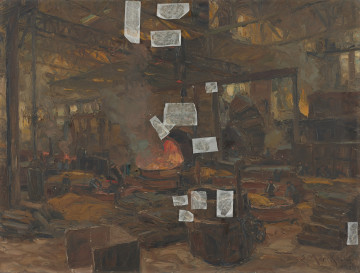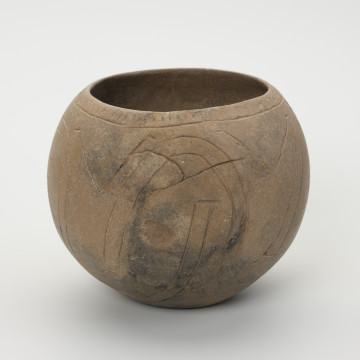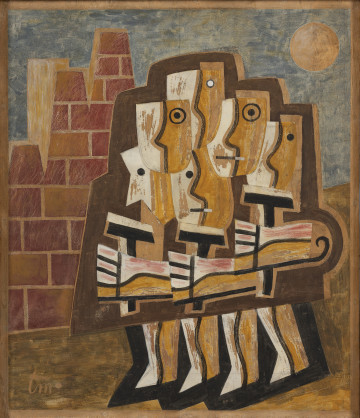
Genre scene, interior scene
2. ćwierć XX wieku
National Museum in Szczecin
Part of the collection: European classics of modernity
The creation of the Belgian state in 1830 coincided with industrialisation processes that turned the young kingdom into a melting pot of modernity. The dynamic development of textile and agriculture-related industries meant that Belgium was seen as a continental little England'. The transit nature of the country at the crossroads between Great Britain, France, the Netherlands and the German states was understood from the outset and a dense network of iron railway routes was laid out. The key was investment in mining and metallurgy, which attracted workers from all over the continent - Greeks, Poles, Italians - to the nine basins. Already in the period before Belgian independence, work in the Walloon industrial belt of the Haine-Sambre-Meuse was immortalised in a series of paintings by the classicist Léonard Defrance. The journey to the black land also influenced a change of subject matter in Constantin Meunier's work. Coming from an artistic family in Brussels and having graduated from the studio of Louis Jehotte at the Academy of Fine Arts in the capital (1845-1854), Meunier began his career as a painter, draughtsman and sculptor. In search of subjects in the late 1870s / early 1890s, he visited many industrial centres: the foundries and rolling mills in Huy, the Cockerill metallurgical works in Seraing, the local Val-Saint-Lambert glassworks, and above all the mines of the Borinage and Charleroi districts. In 1884, a plaster version of the statue of the steel hardener was created based on drawings made in the field. The image of a seated man with a naked reclining torso, wearing a helmet and clogs, was presented at the 1887 Brussels Fine Arts Exhibition. A year later a bronze cast of the sculpture was made. While working on the image of the whole figure, Meunier made a full-figured bust of the same model and a portrait plaque in high relief. The latter was popularised by an edition sold at Julius Meier-Graefe's La Maison Moderne gallery in Paris.
Szymon Piotr Kubiak
Author / creator
Dimensions
cały obiekt: height: 18,4 cm, width: 9,2 cm
Object type
relief
Creation time / dating
Creation / finding place
Identification number
Location / status

2. ćwierć XX wieku
National Museum in Szczecin

5250 p.n.e. — 5000 p.n.e.
National Museum in Szczecin

1947
National Museum in Szczecin
DISCOVER this TOPIC
National Museum in Szczecin
DISCOVER this PATH
Educational path